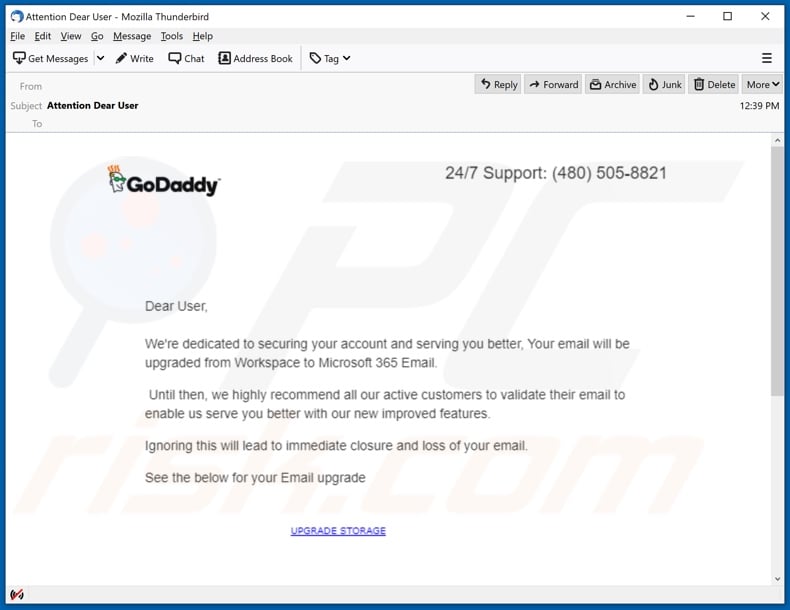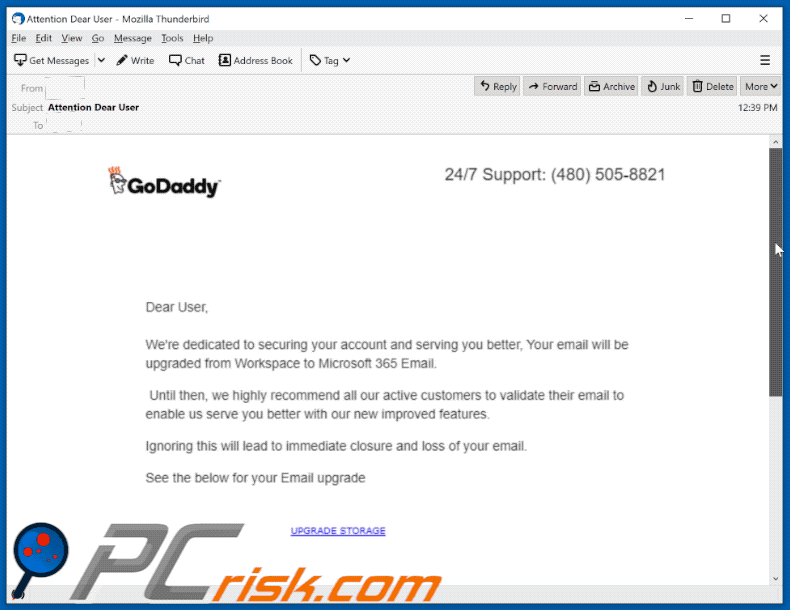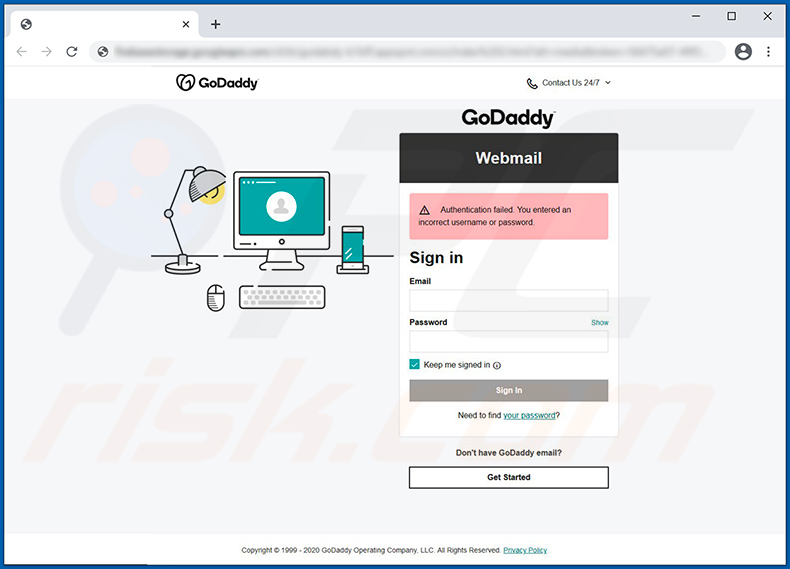Avoid losing your email account via "GoDaddy" phishing emails
Phishing/ScamAlso Known As: GoDaddy spam
Get free scan and check if your device is infected.
Remove it nowTo use full-featured product, you have to purchase a license for Combo Cleaner. Seven days free trial available. Combo Cleaner is owned and operated by RCS LT, the parent company of PCRisk.com.
What is the fake "GoDaddy" email?
"GoDaddy email scam" refers to a spam campaign, a mass-scale operation during which deceptive emails are sent by the thousand.
The emails distributed through this campaign are presented as notifications from GoDaddy, a publicly traded internet domain registrar and web hosting company. These scam messages inform of an upcoming upgrade to the recipients' emails and ask them to verify their email accounts.
This mail promotes a phishing website designed to record entered account log-in credentials (i.e., passwords). Note that all of the information provided by these emails is false, and they are in no way associated with the genuine GoDaddy, Inc.

"GoDaddy" email scam overview
The fake "GoDaddy" emails (subject/title "Attention Dear User"; may vary) claim that recipients' email accounts will be upgraded from "Workspace" to "Microsoft 365 Email". To initiate the upgrade and gain access to new improved features, recipients are asked to validate their email accounts.
The scam messages warn that, should they be ignored, this will result in the accounts being closed/blocked. When "UPGRADE STORAGE" is clicked, recipients are redirected to a phishing site disguised as a sign-in page.
Email addresses and passwords entered into this site are recorded and sent to the scammers, thereby allowing them to steal the corresponding mail accounts. Email accounts are especially targeted by scammers, since they are typically connected with other platforms and services. Therefore, by hijacking mails, access/control may be gained over accounts associated with them.
To elaborate on how this can be used, via communication platforms (e.g., emails, social networking/media, messengers, etc.), scammers can pose as the genuine owner and ask the contacts/friends/followers for loans.
Alternatively, these accounts can be used to spread malware by sharing infectious files and/or links. Finance-related accounts (e.g., banking, online money transferring, digital wallet, e-commerce, etc.) can be used to make fraudulent transactions and online purchases.
To summarize, by trusting "GoDaddy" scam emails, users might experience severe privacy issues, financial losses, and even identity theft.
If attempts to sign-in via the phishing website have already been made, change the log-in credentials of potentially compromised accounts. Furthermore, contact the official supports of the endangered platforms.
| Name | GoDaddy Email Scam |
| Threat Type | Phishing, Scam, Social Engineering, Fraud |
| Fake Claim | Scam emails claim recipients need to validate their email accounts to upgrade them. |
| Disguise | Scam emails are disguised as mail from GoDaddy |
| Symptoms | Unauthorized online purchases, changed online account passwords, identity theft, illegal access of the computer. |
| Distribution methods | Deceptive emails, rogue online pop-up ads, search engine poisoning techniques, misspelled domains. |
| Damage | Loss of sensitive private information, monetary loss, identity theft. |
| Malware Removal (Windows) |
To eliminate possible malware infections, scan your computer with legitimate antivirus software. Our security researchers recommend using Combo Cleaner. Download Combo CleanerTo use full-featured product, you have to purchase a license for Combo Cleaner. 7 days free trial available. Combo Cleaner is owned and operated by RCS LT, the parent company of PCRisk.com. |
Phishing spam campaign examples
Phishing scams target not only account log-in credentials but other sensitive/personal details as well. "Facebook Lottery", "Banca Popolare di Bari email scam", "BAPATOH OFFSHORE SDN BHD", "PASSWORD EXPIRATION NOTICE", and "Spotify email scam" are some examples of phishing spam campaigns.
The deceptive messages are often disguised as "official", "urgent", "important", and similar. They may even be presented as messages from legitimate organizations, institutions, companies, service providers, and other entities.
As well as various scams, these campaigns are also used to proliferate malware (e.g., ransomware, trojans, etc.). Due the widespread nature of spam mail is, exercise caution with incoming emails.
How do spam campaigns infect computers?
Malware (including ransomware) is usually distributed via malspam campaigns, unofficial software activation ('cracking') tools, Trojans, dubious file/software download sources, and fake software updating tools.
When cyber criminals attempt to distribute malware via malspam campaigns, they send emails that contain malicious attachments or download links for malicious files. Typically, they disguise their emails as official and important. If recipients open the attached file (or a file downloaded via a website link), they cause installation of malicious software.
Cyber criminals commonly attach executable files (.exe), archive files such as RAR, ZIP, PDF documents, JavaScript files and Microsoft Office documents to their emails. Software 'cracking' tools supposedly activate licensed software illegally (bypass activation), however, they often install malicious programs and do not activate any legitimate installed software.
Trojans are other rogue programs that can cause chain infections. I.e., when a Trojan is installed on the operating system, it can install additional malware.
Free file hosting websites, freeware download websites, Peer-to-Peer networks (e.g., torrent clients, eMule), unofficial websites, and third party downloaders are examples of other sources that are used to distribute malware. Cyber criminals disguise malicious files as legitimate and regular. When users download and open them, they inadvertently infect their computers with malware.
Fake software updating tools install malicious software rather than updates/fixes for installed programs, or they exploit bugs/flaws of outdated software that is installed on the operating system.
How to avoid installation of malware
Do not trust irrelevant emails that have files attached (or contain website links) and are received from unknown, suspicious addresses. Software should not be downloaded or installed through third party downloaders, installers, unofficial pages or other similar sources/tools.
Use only official websites and direct links. Installed software should never be updated or activated with third party, unofficial tools, since they can install malware. Furthermore, it is illegal to use third party tools to activate licensed software.
The only legitimate way to update and activate software is to use tools and functions that are provided by the official developers. Regularly scan your computer with reputable antivirus or anti-spyware software and keep this software up to date.
If you have already opened malicious attachments, we recommend running a scan with Combo Cleaner Antivirus for Windows to automatically eliminate infiltrated malware.
Text presented in the fake "GoDaddy" email message:
Subject: Attention Dear User
GoDaddy
24/7 Support: (480) 505-8821
Dear User,
WE're dedicated to securing your account and serving you better, Your email will be upgraded from Workspace to Microsoft 365 Email.
Until then, we highly recommend all our active customers to validate their email to enable us serve you better with our new improved features.
Ignoring this will lead to immediate closure and loss of your email.
See the below for your Email upgrade
UPGRADE STORAGE
Blake Irving
CEO, GoDaddy
Copyright © 1999-2021 GoDaddy Operating Company, LLC. 14455 N. Hayden Rd, Ste. 219, Scottsdale, AZ 85260, USA. All Rights Reserved.
Appearance of the "GoDaddy" scam email (GIF):

Screenshot of the phishing website promoted by the "GoDaddy" spam campaign:

Instant automatic malware removal:
Manual threat removal might be a lengthy and complicated process that requires advanced IT skills. Combo Cleaner is a professional automatic malware removal tool that is recommended to get rid of malware. Download it by clicking the button below:
DOWNLOAD Combo CleanerBy downloading any software listed on this website you agree to our Privacy Policy and Terms of Use. To use full-featured product, you have to purchase a license for Combo Cleaner. 7 days free trial available. Combo Cleaner is owned and operated by RCS LT, the parent company of PCRisk.com.
Quick menu:
- What is GoDaddy spam?
- Types of malicious emails.
- How to spot a malicious email?
- What to do if you fell for an email scam?
Types of malicious emails:
![]() Phishing Emails
Phishing Emails
Most commonly, cybercriminals use deceptive emails to trick Internet users into giving away their sensitive private information, for example, login information for various online services, email accounts, or online banking information.
Such attacks are called phishing. In a phishing attack, cybercriminals usually send an email message with some popular service logo (for example, Microsoft, DHL, Amazon, Netflix), create urgency (wrong shipping address, expired password, etc.), and place a link which they hope their potential victims will click on.
After clicking the link presented in such email message, victims are redirected to a fake website that looks identical or extremely similar to the original one. Victims are then asked to enter their password, credit card details, or some other information that gets stolen by cybercriminals.
![]() Emails with Malicious Attachments
Emails with Malicious Attachments
Another popular attack vector is email spam with malicious attachments that infect users' computers with malware. Malicious attachments usually carry trojans that are capable of stealing passwords, banking information, and other sensitive information.
In such attacks, cybercriminals' main goal is to trick their potential victims into opening an infected email attachment. To achieve this goal, email messages usually talk about recently received invoices, faxes, or voice messages.
If a potential victim falls for the lure and opens the attachment, their computers get infected, and cybercriminals can collect a lot of sensitive information.
While it's a more complicated method to steal personal information (spam filters and antivirus programs usually detect such attempts), if successful, cybercriminals can get a much wider array of data and can collect information for a long period of time.
![]() Sextortion Emails
Sextortion Emails
This is a type of phishing. In this case, users receive an email claiming that a cybercriminal could access the webcam of the potential victim and has a video recording of one's masturbation.
To get rid of the video, victims are asked to pay a ransom (usually using Bitcoin or another cryptocurrency). Nevertheless, all of these claims are false - users who receive such emails should ignore and delete them.
How to spot a malicious email?
While cyber criminals try to make their lure emails look trustworthy, here are some things that you should look for when trying to spot a phishing email:
- Check the sender's ("from") email address: Hover your mouse over the "from" address and check if it's legitimate. For example, if you received an email from Microsoft, be sure to check if the email address is @microsoft.com and not something suspicious like @m1crosoft.com, @microsfot.com, @account-security-noreply.com, etc.
- Check for generic greetings: If the greeting in the email is "Dear user", "Dear @youremail.com", "Dear valued customer", this should raise suspiciousness. Most commonly, companies call you by your name. Lack of this information could signal a phishing attempt.
- Check the links in the email: Hover your mouse over the link presented in the email, if the link that appears seems suspicious, don't click it. For example, if you received an email from Microsoft and the link in the email shows that it will go to firebasestorage.googleapis.com/v0... you shouldn't trust it. It's best not to click any links in the emails but to visit the company website that sent you the email in the first place.
- Don't blindly trust email attachments: Most commonly, legitimate companies will ask you to log in to their website and to view any documents there; if you received an email with an attachment, it's a good idea to scan it with an antivirus application. Infected email attachments are a common attack vector used by cybercriminals.
To minimise the risk of opening phishing and malicious emails we recommend using Combo Cleaner Antivirus for Windows.
Example of a spam email:

What to do if you fell for an email scam?
- If you clicked on a link in a phishing email and entered your password - be sure to change your password as soon as possible. Usually, cybercriminals collect stolen credentials and then sell them to other groups that use them for malicious purposes. If you change your password in a timely manner, there's a chance that criminals won't have enough time to do any damage.
- If you entered your credit card information - contact your bank as soon as possible and explain the situation. There's a good chance that you will need to cancel your compromised credit card and get a new one.
- If you see any signs of identity theft - you should immediately contact the Federal Trade Commission. This institution will collect information about your situation and create a personal recovery plan.
- If you opened a malicious attachment - your computer is probably infected, you should scan it with a reputable antivirus application. For this purpose, we recommend using Combo Cleaner Antivirus for Windows.
- Help other Internet users - report phishing emails to Anti-Phishing Working Group, FBI’s Internet Crime Complaint Center, National Fraud Information Center and U.S. Department of Justice.
Frequently Asked Questions (FAQ)
Why did I receive this email?
Cyber criminals distribute spam mail in mass-scale operations. Therefore, thousands of users receive identical emails.
I have provided my personal information when tricked by this spam email, what should I do?
If you have provided account credentials - change the passwords of all potentially exposed accounts and inform their official support without delay. While if you have disclosed personally identifiable or financial information (e.g., credit card numbers, etc.) - immediately contact the corresponding authorities.
I have read a spam email but didn't open the attachment, is my computer infected?
No, merely reading a spam email will not initiate any system infection processes. Malware download/installation is jumpstarted when the attachments or links found in this mail are opened/clicked.
I have downloaded and opened a file attached to a spam email, is my computer infected?
If it was an executable (.exe, .run, etc.) - most likely, yes - your system was infected. On the other hand, documents (.pdf, .doc, .xls, etc.) may require additional user interaction (e.g., enabling macro commands) to begin downloading/installing malicious software.
Will Combo Cleaner remove malware infections present in email attachments?
Yes, Combo Cleaner is capable of detecting and eliminating practically all known malware infections. It has to be mentioned that performing a full system scan is essential - since sophisticated malicious software tends to hide deep within systems.
Share:

Tomas Meskauskas
Expert security researcher, professional malware analyst
I am passionate about computer security and technology. I have an experience of over 10 years working in various companies related to computer technical issue solving and Internet security. I have been working as an author and editor for pcrisk.com since 2010. Follow me on Twitter and LinkedIn to stay informed about the latest online security threats.
PCrisk security portal is brought by a company RCS LT.
Joined forces of security researchers help educate computer users about the latest online security threats. More information about the company RCS LT.
Our malware removal guides are free. However, if you want to support us you can send us a donation.
DonatePCrisk security portal is brought by a company RCS LT.
Joined forces of security researchers help educate computer users about the latest online security threats. More information about the company RCS LT.
Our malware removal guides are free. However, if you want to support us you can send us a donation.
Donate
▼ Show Discussion